科普版英语七年级上册全册优质课件
合集下载
科普版英语七年级上册全册优质课件【精品】

A: Mr. Brown, this is my mom.
Mom, ___B__ my teacher,
Mr. Brown. B: How do you do?
A:______C_______?
Listen again and fill in the blanks.
A: Lily, __th_i_s_i_s__my teacher,
Miss Wang. B: __N_i_c_e_t_o_m__e_e_t_y_o_u_,
Notice
当别人问你“Are you …?”时,否定回答应为: No, I am not. I am ... / No. I am ...。 注:不能只回答No, I am not. 英语中,这样的回答 会被认为是不礼貌的行为。
Nice to see you. 答语通常为Nice to see you, too. 这样的问候常在以下两种情景中使用: 1.双方初次见面经人介绍后互相问候。 2.熟悉的人好久不见,偶然相逢时表达双方见面后的
Shanghai Hong Kong China the USA
Good morning! I am …
Welcome to China.
Good morning! I am…
Look, listen and understand.
Hello!
Hello!
I’m Kangkang. Are you Michael?
yours is the big, please go to the small letter, and say:
We are “ b, B”.
We arwe “b, B”.
For example:
bB
Play the English letter games:
Mom, ___B__ my teacher,
Mr. Brown. B: How do you do?
A:______C_______?
Listen again and fill in the blanks.
A: Lily, __th_i_s_i_s__my teacher,
Miss Wang. B: __N_i_c_e_t_o_m__e_e_t_y_o_u_,
Notice
当别人问你“Are you …?”时,否定回答应为: No, I am not. I am ... / No. I am ...。 注:不能只回答No, I am not. 英语中,这样的回答 会被认为是不礼貌的行为。
Nice to see you. 答语通常为Nice to see you, too. 这样的问候常在以下两种情景中使用: 1.双方初次见面经人介绍后互相问候。 2.熟悉的人好久不见,偶然相逢时表达双方见面后的
Shanghai Hong Kong China the USA
Good morning! I am …
Welcome to China.
Good morning! I am…
Look, listen and understand.
Hello!
Hello!
I’m Kangkang. Are you Michael?
yours is the big, please go to the small letter, and say:
We are “ b, B”.
We arwe “b, B”.
For example:
bB
Play the English letter games:
最新科普(仁爱)版英语七年级上册Unit2 Topic2 SectionC【市级公开课一等奖课件】
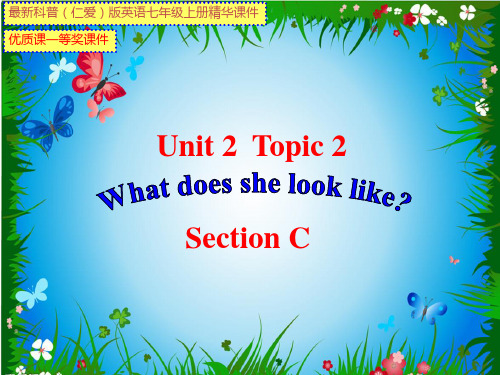
ine the children’s clothes and circle the words of colors.
Read 2a and complete the table.
Name Hair
Maria short, brown
Michael
blond
Jane
Kangkang
red
B: They’re _p__in_k__. A: What color are _t_h_o_s_e_ pants? B: _T_h_e_y_’r_e_ blue.
Read and understand.
Girl: Mom, I want to buy a T-shirt, a cap and a pair of shoes.
Can you describe “The Happy Family”?
dad
mom
Read the sounds and then write the words.
1. glove color
/ʌ/
2. blue shoe
/u:/
3. look good
/u/
4. black blond blue color yellow glove /l/
skirt gloves
ShWe ohfotseengwloevaerss aarbelathcekssek?irt.
Please match. T-shirt
cap
coat
dress
shoes
pants
skirt
Complete the conversations and then practice with your partner.
5. will want woman white /w/
Read 2a and complete the table.
Name Hair
Maria short, brown
Michael
blond
Jane
Kangkang
red
B: They’re _p__in_k__. A: What color are _t_h_o_s_e_ pants? B: _T_h_e_y_’r_e_ blue.
Read and understand.
Girl: Mom, I want to buy a T-shirt, a cap and a pair of shoes.
Can you describe “The Happy Family”?
dad
mom
Read the sounds and then write the words.
1. glove color
/ʌ/
2. blue shoe
/u:/
3. look good
/u/
4. black blond blue color yellow glove /l/
skirt gloves
ShWe ohfotseengwloevaerss aarbelathcekssek?irt.
Please match. T-shirt
cap
coat
dress
shoes
pants
skirt
Complete the conversations and then practice with your partner.
5. will want woman white /w/
Unit 4 - 七年级英语上册精美课件(仁爱科普版2024)
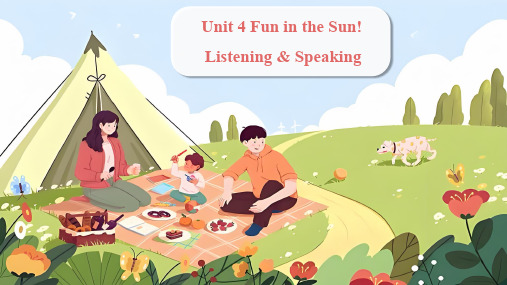
Unit 4 Fun in the Sun! Listening & Speaking
Learning aims
1.在看、听、说的活动中,了解不同季节的天气特征及适合进 行的活动,形成结构化知识; 2.使用和季节、天气、活动相关的目标语言分享个人在不同季 节最喜欢的活动; 3.在小组内交流各自最喜爱的季节和活动等信息,简要总结后 和全班分享。
[ˈweðər]
summer
autumn
winter
B: It’s __w__a_rm___. /wɔː(r)m/ hot /hɒt/ /hɑːt/ cool /kuːl/ cold /kəʊld/
Activity 1 A.Match the seasons with the pictures (1-4) and then connect each season with its suitable weather.
B: I like _m__ak_i_n_g__a_s_n_o_w_m__a_n_ with my parents/friends. going skiing [ˈskiːɪŋ] going skating [ˈskeɪtɪŋ]
Activity 1 B. Read the sentences and complete them with the words above.
A: What do you like doing in autumn? B: I like hiking with my family.
Activity 1
C. Pair work. Listen and repeat, and then replace the parts in bold and practice with your partner.
Learning aims
1.在看、听、说的活动中,了解不同季节的天气特征及适合进 行的活动,形成结构化知识; 2.使用和季节、天气、活动相关的目标语言分享个人在不同季 节最喜欢的活动; 3.在小组内交流各自最喜爱的季节和活动等信息,简要总结后 和全班分享。
[ˈweðər]
summer
autumn
winter
B: It’s __w__a_rm___. /wɔː(r)m/ hot /hɒt/ /hɑːt/ cool /kuːl/ cold /kəʊld/
Activity 1 A.Match the seasons with the pictures (1-4) and then connect each season with its suitable weather.
B: I like _m__ak_i_n_g__a_s_n_o_w_m__a_n_ with my parents/friends. going skiing [ˈskiːɪŋ] going skating [ˈskeɪtɪŋ]
Activity 1 B. Read the sentences and complete them with the words above.
A: What do you like doing in autumn? B: I like hiking with my family.
Activity 1
C. Pair work. Listen and repeat, and then replace the parts in bold and practice with your partner.
Unit+4Exploring+the+Topic课件2024-2025学年仁爱科普版英语七年级上册
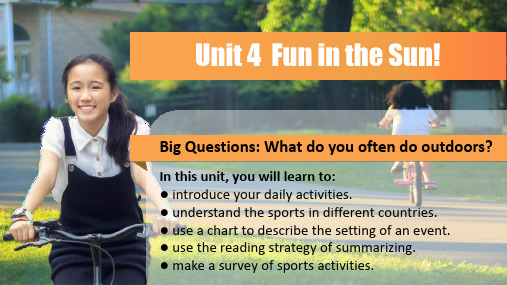
Write a passage about this picture.
Here are 2 short passage about this picture. Which is better ? Why ?
The girl is playing Chinese yo-yo.
weather time It's sunny in the morning.
___________ ___________
Weather:
___________ ___________
From the setting, we know some basic information about the passage.
The setting of _p_l_a_y_in_g__b_a_s_e_b_all
Place:
o__u_t_d_o_o__rs__o_r i_n_d__o_o_r_s____
Time:
a__ll_y_e__a_r____ l_o_n__g_______
Weather:
_s_u__n_n_y__o_r__ _c_l_o_u__d_y____ _r_a_i_n_y______
Time:
___________ ___________
Weather:
___________ ___________
➢ Activity 2
Read the text and complete the setting chart.
Many Americans love playing baseball. They play baseball all year long. On sunny or cloudy days, they play it outdoors. On rainy days, they play it indoors.
Here are 2 short passage about this picture. Which is better ? Why ?
The girl is playing Chinese yo-yo.
weather time It's sunny in the morning.
___________ ___________
Weather:
___________ ___________
From the setting, we know some basic information about the passage.
The setting of _p_l_a_y_in_g__b_a_s_e_b_all
Place:
o__u_t_d_o_o__rs__o_r i_n_d__o_o_r_s____
Time:
a__ll_y_e__a_r____ l_o_n__g_______
Weather:
_s_u__n_n_y__o_r__ _c_l_o_u__d_y____ _r_a_i_n_y______
Time:
___________ ___________
Weather:
___________ ___________
➢ Activity 2
Read the text and complete the setting chart.
Many Americans love playing baseball. They play baseball all year long. On sunny or cloudy days, they play it outdoors. On rainy days, they play it indoors.
初中英语仁爱科普版七年级上 Unit 3 Topic 3 Section D 课件 (共24张PPT)
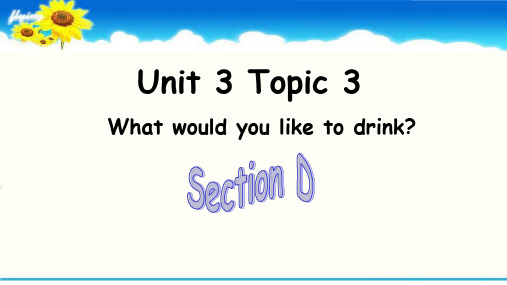
2020/8/27
你能区分哪些是可数名词,哪些是不可数名词吗
可数名词
2020/8/27
tomato oebrrbwgamieagcnaaenitgldekaerna
不可数名词
你能区分哪些是可数名词,哪些是不可数名词吗
可数名词
2020/8/27
havfdaphebijrsmpuagoihnliexberckteuajurbgilceer
2020/8/27
egg milk rice water bread apple chicken orange vegetable
hamburger fish food dinner lunch20 Nhomakorabea0/8/27
可数名词: _e_g_g________h_a_m__b_u_rg_e_r_______v_e_g_e_t_a_b_le__________ __l_u_n_c_h_______o_ra_n_g_e_______d_in_n_e_r____a_p_p_le________ 不可数名词: __m_i_lk_______r_ic_e______w__a_te_r_______b_r_e_a_d_________ __ch__ic_k_e_n_____f_is_h_____f_o_o_d_____________________
meals and making suggestions. 4. Learn how to write an English letter.
rs x z v l u n c h ba b u e f o o d o ia e g g i p l y r ap p l e s u e w a cg h j t h w g a n hb r e a s a s t g ir u i b o s i e e ce m i l k j r r l ka n k e d f i i c ed i n n e r c c u nh a m b u r g e r
你能区分哪些是可数名词,哪些是不可数名词吗
可数名词
2020/8/27
tomato oebrrbwgamieagcnaaenitgldekaerna
不可数名词
你能区分哪些是可数名词,哪些是不可数名词吗
可数名词
2020/8/27
havfdaphebijrsmpuagoihnliexberckteuajurbgilceer
2020/8/27
egg milk rice water bread apple chicken orange vegetable
hamburger fish food dinner lunch20 Nhomakorabea0/8/27
可数名词: _e_g_g________h_a_m__b_u_rg_e_r_______v_e_g_e_t_a_b_le__________ __l_u_n_c_h_______o_ra_n_g_e_______d_in_n_e_r____a_p_p_le________ 不可数名词: __m_i_lk_______r_ic_e______w__a_te_r_______b_r_e_a_d_________ __ch__ic_k_e_n_____f_is_h_____f_o_o_d_____________________
meals and making suggestions. 4. Learn how to write an English letter.
rs x z v l u n c h ba b u e f o o d o ia e g g i p l y r ap p l e s u e w a cg h j t h w g a n hb r e a s a s t g ir u i b o s i e e ce m i l k j r r l ka n k e d f i i c ed i n n e r c c u nh a m b u r g e r
科普版七年级英语上册《Topic 2 What does your mother do. Section B》公开课课件_1

A: What does he do? B: He is an office worker.
A: What does he do? B: He is a cook.
A: What does she do? B: She is a doctor.
A: What does he do? B: He is a student.
What does he do? He is an office worker. Where does he work? He works in an office.
What do they do? They are students.
Where do they study? They study in a school.
4. He drives a bus. He is a __d_r_i_v_e_r __. 5. Her mother works in an office. She is an __o_f_fi_c_e_w__o_rk_e_r.
farm + er——farmer work + er——worker
Unit3 Getting Together
Topic 2
What does your mother do?
Section B
A: What does he do? B: He is a teacher.
A: What do they do? B: They are farmers.
A: What does he do? B: He is a driver.
office restaurant farm hospital
What does he do? He is a doctor. Where does he work? He works in a hospital.
科普版-英语-七上-2单元 Topic1 SectionC 精品课件
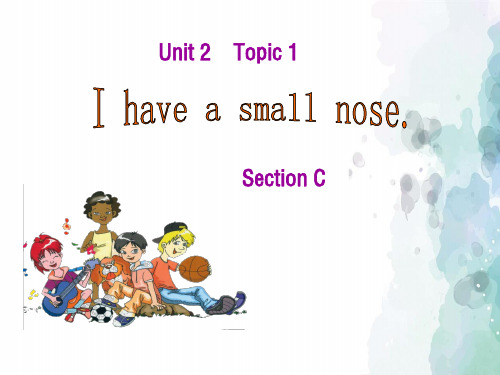
a knife
three knives
a ruler
three rulers
A
C
B
D
Work in groups. Ask what your classmates have after the examples.
Example 1:
A: Do you have ...? B: Yes, I do. / No, I don’t. A: Does B have ...? C: Yes, he/she does. / No, he/she doesn’t.
different 不同的
We are in different schools. = We are not in the same school.
The two apples are different.
Can you retell the passage according to the key words?
thirteen
my sister Amy
England
twelve
I a round face
small eyes a big nose a small mouth
she a round face
big eyes a small nose a small mouth
the same school different grades
4. We are in different schools. 5. We are in the same grade.
(
(
)
)
F F
I am a boy. I’m _t_h_ir_te_e_nyears old. I come from England. I’m a student. I havea__ro_u_n_d__fa_c_eand _sm__a_ll_e_y_e_s__. My nose is _b_ig__, and my m__o_u_th__ is _sm__a_ll__. I have a sister. Her name is Amy. She is twelve. She is a student, too. She hasa__ro_u_n_d__fa_c_e, big eyes, a small nose and a small mouth. We are in the same school, but in _d_if_fe_r_e_n_t grades.
科普版-英语-七上-2单元 Topic2 SectionC 精品课件

1. 学习表示服装的名词: cap coat T-shirt skirt
dress shoes pants gloves
2. 学习描述人的着装: The girl is in white.
She is in a white coat. Tom is in black pants.
Try to write a short passage to describe your families.
Please match. T-shirt
cap
coat
dress
shoes
pants
skirt
Complete the conversations and then practice with your partner.
A:W__h__a_t_c_o_l_o_ris this skirt?
B: It’s yellow. A: What color _is__ that __d_r_e_ss_? B: It’s o_r_a_n_g_e__.
Michael
blond
Jane
Kangkang
red
black
Clothes
a yellow dress
a black cap and blue shoes
a purple a white
T-shirt and T-shirt and a pink shirt blue pants
in 穿着,戴着
/ʌ/
2. blue shoe
/u:/
3. look good
/u/
4. black blond blue color yellow glove /l/
5. will want woman white /w/
科普(仁爱)版英语七年级上册Unit2-Topic1-SectionC【优质课ppt课件】
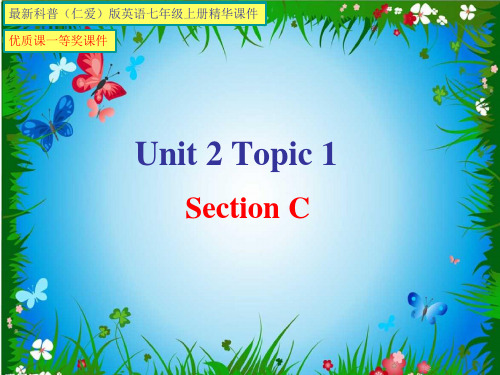
最新科普(仁爱)版英语七年级上册精华课件 优质课一等奖课件
Unit 2 Topic 1
Section C
Touch your head. Touch your eyes. Touch your nose. Touch your mouth. Touch your hair. Touch your arm.
Look at the pictures and find out the differences.
Read the passage and answer the questions.
1. Where does the boy come from(来自于)? He comes from England.
Boy
round small
big
mouth small
Girl round big
small small
Mark T (True) or F(false).
1. My face is round and my mouth is small. T 2. Amy is ten. F
3. Amy has big eyes and a small nose. T
a round face
a long face
big eyes
small eyes
a small nose
a long nose
a big mouth
a small mouth
long hair
short hair
one
two three four
Choose one number and describe the person.
4. We are in different schools. F
Unit 2 Topic 1
Section C
Touch your head. Touch your eyes. Touch your nose. Touch your mouth. Touch your hair. Touch your arm.
Look at the pictures and find out the differences.
Read the passage and answer the questions.
1. Where does the boy come from(来自于)? He comes from England.
Boy
round small
big
mouth small
Girl round big
small small
Mark T (True) or F(false).
1. My face is round and my mouth is small. T 2. Amy is ten. F
3. Amy has big eyes and a small nose. T
a round face
a long face
big eyes
small eyes
a small nose
a long nose
a big mouth
a small mouth
long hair
short hair
one
two three four
Choose one number and describe the person.
4. We are in different schools. F
科普版-英语-七上-1单元 Topic1 SectionA参考课件

3a
Look, listen and say
Hello!
Hello!
I’m Kangkang. Are you Michael?
Yes, I am.
Hello! Are you Maria?
No, I’m not. I’m Jane.
Oh, nice to meet you, Jane. Hi, Maria!
A: Hi/Hello, I am … Are you …?
B: No, I’m not. I am … A: Nice to meet you. B: Nice to meet you, too.
Are you Kangkang?
Yes, I am.
Thanks.
Welcome to China !
1. Please imagine and list some objects which have the same shape with the English letters.
Such as: The legs of a chair are like “A”,ears are like “B”. The moon is like C or D, etc.
②After all the students complete the first game, then the first one says “AB”, the second one follows with “BC” quickly, the third one “CD” and so on, until all the students take part in the game.
句型:Good morning. I am … Nice to meet you.
Unit+3++Grammar+in+Use+课件2024-2025学年科普版英语七年级上册++
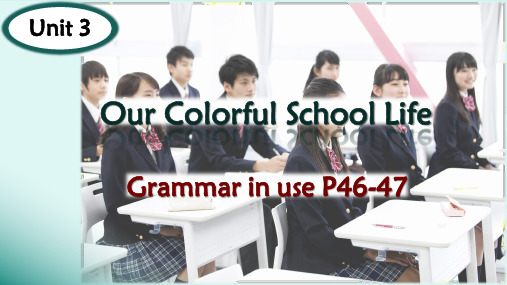
Mike is an American boy. At an American school, (student/stu√dents) meet their class teacher at the start of the (√day/days). During the day, they go to different (classsroom/ class√rooms) for different subjects. After school. they take part in the club (activity/act√ivities). Mike is in the science (c√lub/clubs). At the club, he makes (fr√iends/friend) with students from America and other (country/cou√ntries). during /ˈdjʊərɪŋ/;/ˈdʊrɪŋ/ prep. 在……期间
Singular watch glass dish tomato toy country half Plural watches glasses dishes tomatoes toys countries halves
1. 以ch, sh, s结尾的名词, 变成复数加es; 2. 以o结尾的名词,n属egr于o/两her人o/和po两tat菜o/,tom变at成o 复数加es; 3. 以元音字母加 y 结尾的名词, 变成复数加s; 4. 以辅音字母加 y 结尾的名词, 变复数先把 y变为i, 再加es; 5. 以f结尾的名词, 变成复数先把f变为ve, 再加s。
都加s;hero-heroes potato-potatoes zoo-zoos photo-photos
Singular watch glass dish tomato toy country half Plural watches glasses dishes tomatoes toys countries halves
1. 以ch, sh, s结尾的名词, 变成复数加es; 2. 以o结尾的名词,n属egr于o/两her人o/和po两tat菜o/,tom变at成o 复数加es; 3. 以元音字母加 y 结尾的名词, 变成复数加s; 4. 以辅音字母加 y 结尾的名词, 变复数先把 y变为i, 再加es; 5. 以f结尾的名词, 变成复数先把f变为ve, 再加s。
都加s;hero-heroes potato-potatoes zoo-zoos photo-photos
- 1、下载文档前请自行甄别文档内容的完整性,平台不提供额外的编辑、内容补充、找答案等附加服务。
- 2、"仅部分预览"的文档,不可在线预览部分如存在完整性等问题,可反馈申请退款(可完整预览的文档不适用该条件!)。
- 3、如文档侵犯您的权益,请联系客服反馈,我们会尽快为您处理(人工客服工作时间:9:00-18:30)。
Welcome to China ! — Good morning! — Good morning! I’m Kangkang. Hello! / Hi! — Are you Maria? — Yes, I am. / No, I’m not. I’m Jane. —Nice to meet you. — Nice to meet you, too. Thanks.
1a Look, listen and say.
How do you do? How do you do?
This is Maria.
This is Michael.
This is my teacher, Mr. Brown…
This is…
这是……
This is…句型通常在两种情境中使用: 1.向别人介绍第三方时; 2.用来介绍、说明某种事物。
Nice to see you. 答语通常为Nice to see you, too. 这样的问候常在以下两种情景中使用: 1.双方初次见面经人介绍后互相问候。 2.熟悉的人好久不见,偶然相逢时表达双方见面后的 高兴心情。
Practice.
Are you Lily?
Yes, I am.
Welcome to China !
Unit 1 Making New Friends
Section B
T: Good morning. S: Good morning. T: I’m ..., are you ...? S: Yes, I am. T: Nice to see you. S: Nice to see you, too.
A: Mr. Brown, this is my mom. B my teacher, Mom, _____ Mr. Brown. B: How do you do? A:_____________? C
Listen again and fill in the blanks.
A: Lily, ________my teacher, this is Miss Wang. Nice to meet you B: ________________, Miss Wang.
How do you do?
? ? ?
Nice to see you..
Listen to the conversations and number the pictures. 3
2 1
Listen again and choose.
A. Nice to see you B. This is C. How do you do
Listen and number the following letters. Then circle the letters with the same sound as Bb.
Aa Bb
( 3) ( 5 )
Cc
(2 )
Dd
(1)
Ee
( )
Ff
( 6)
Gg(4 )7 Nhomakorabea/i:/
Play the English letter games:
Thanks.
Practice. Hello! Hello ________!
Nice to see you, Yingying.
Nice to see you, too, _________________________ Huanhuan. _______________
Listen, say and trace.
Shanghai Hong Kong the USA China
Good morning! I am … Welcome to China.
Good morning! I am…
Look, listen and understand.
Hello! I’m Kangkang. Are you Michael? Hello! Are you Maria? Hello!
Yes, I am.
No, I’m not. I’m Jane.
Oh, nice to meet you, Jane. Hi, Maria!
Nice to meet you, too. Hi, Kangkang!
Welcome to China!
Thanks.
Notice
当别人问你“Are you …?”时,否定回答应为: No, I am not. I am ... / No. I am ...。 注:不能只回答No, I am not. 英语中,这样的回答 会被认为是不礼貌的行为。
w “b, B”. We are
For example:
b
B
Play the English letter games:
① The first student in the first team says “A” quickly, the second student follows with “B”,and the other students follow with “C,D,E,F,G,A, B ...” one by one.
科普版七年级上册
英 语 全册优质课件
Unit 1 Making New Friends
Please discuss why we should study English.
Kangkang Michael
Jane
Maria
Greet and introduce yourselves.
Good morning! I’m Tom…
Each student writes one of the English letters (big or small) on the paper, and some students go to the front of the classroom and hand up their paper. If you see the big letter, but yours is the small, please go to the big letter. If you see the small letter, but yours is the big, please go to the small letter, and say: We are “ b, B”.
